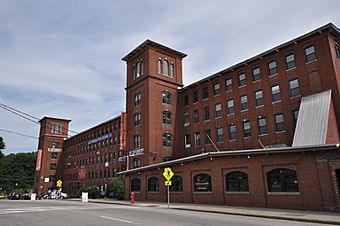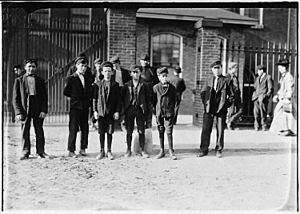Cocheco Mills facts for kids
Quick facts for kids |
|
|
Cocheco Mills
|
|

Mill #1
|
|
| Location | Main and Washington Sts., Dover, New Hampshire |
|---|---|
| Area | 11.5 acres (4.7 ha) |
| Built | 1822 |
| Architect | Multiple |
| NRHP reference No. | 14000081 |
| Added to NRHP | March 26, 2014 |
The Cocheco Mills are a group of historic factory buildings in Dover, New Hampshire. These mills are located right in the heart of the city. They sit by a bend in the Cochecho River.
This spot has been used for factories since at least 1822. That's when the Dover Cotton Factory was first built there. The buildings you see today were mostly built between the 1880s and the early 1900s. They were added to the National Register of Historic Places in 2014. This means they are important historical sites.
Contents
What are the Cocheco Mills?

The Cocheco Mills complex includes several important parts. There are six main factory buildings. It also has the dam and wheel house that helped control water for the mills. A steel bridge, a tall smokestack, and parts of the old boiler house are also still there.
Important Parts of the Mills
The Dam and Bridge
The dam stretches across the Cocheco River. It is shaped like a wide curve. This dam is made from large, rough-cut granite stones. It stands between 9 and 150 feet tall. Today, it has a modern concrete spillway. The dam was built sometime between 1905 and 1925. It replaced an older dam that was there before.
The wheel house is a small brick building. It is only one story tall. It sits on a concrete arch that goes over the river. This building helped control the water power for the mills.
The bridge is made of steel. It crosses the river west of Mill #3. It was likely built in the 1880s. The bridge has a wooden top and a fancy railing.
The Main Mill Buildings
There are four main mill buildings in the complex.
- Mill #1 is a five-story brick building. It is located south of Washington Street. This mill was built in 1908. The old Mill #1 had been destroyed by a fire. Some parts of the older building were used again in the new one.
- Mill #2 was built in 1880. It is at the northern end of the complex. This is a four-story brick building. It connects to Mill #3 at its south end.
- Mill #3 was built in 1881. This building actually goes over the river itself. An L-shaped part was added in 1909. This new section replaced the old Mill #4.
- Mill #5 was built in 1825. It is the oldest building still standing in the complex. It used to be much longer. Part of it was taken down in the mid-1900s. Now, it has a special Gothic Revival tower. A bell tower was added to it in the 1850s.
What are Picker Houses?
There are two picker houses in the complex. Both were built between 1905 and 1925.
- Picker House #1 is next to Mill #1. It is a three-story brick building. It is connected to Mill #1 by two enclosed bridges.
- Picker House #2 is at the north end of the complex. It is also a three-story brick building. Because of the land, one side only looks like two stories. It used to be connected to Mill #2 by a bridge, but that bridge is gone now.
A Look at the Mills' History
Early Days and Important Events
The Cocheco Mills started working in 1823. In 1828, something very important happened here. It was the site of one of the first textile mill strikes. A strike is when workers stop working to demand better conditions. This strike was special because women workers were almost entirely involved.
The Cocheco Mill Company ran the mills until 1909. Then, a company called Pacific Mill Works bought the factory. They were from Lawrence, Massachusetts. Besides making textiles (cloth), Pacific also ran the Cocheco Print Works here. This is where patterns were printed onto fabrics.
Changes Over Time
In the 1930s, the mills faced tough times. Factories in the southern United States started making textiles more cheaply. Also, the Great Depression in the United States made it hard for businesses. The Great Depression was a time when many people lost their jobs and money. Because of these problems, Pacific Mill Works closed the complex in 1937.
The city of Dover bought the mills in 1940. They bought them at an auction. Since then, many smaller businesses have used the buildings. Most of these businesses made different products. Today, some of the buildings have been turned into apartments where people live.



